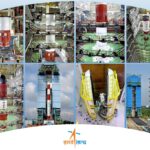The NASA-ISRO Synthetic Aperture Radar (NISAR) satellite successfully launched on July 30, 2025, at 5:40 PM IST from the Satish Dhawan Space Centre. Carried aloft by ISRO’s Geosynchronous Satellite Launch Vehicle (GSLV-F16), the launch marks the culmination of a decade-long joint effort between the Indian Space Research Organization (ISRO) and the U.S. National Aeronautics and Space Administration (NASA).
NISAR, the first dual-frequency (L-band and S-band) radar imaging satellite, is poised to revolutionize our understanding of Earth’s dynamic land and ice surfaces. The mission, with a price tag of $1.5 billion, stands as the most expensive Earth observation satellite to date, underscoring the critical importance placed on its data by global scientific communities.
Orbiting at a 743-km Sun-synchronous altitude, NISAR will scan the entire Earth’s land and ice surfaces every 12 days, providing unprecedented high-resolution data. This continuous monitoring will be vital for:
- Climate Change: Tracking subtle changes in glaciers, ice sheets, and sea levels.
- Natural Hazards: Early detection and assessment of earthquakes, tsunamis, volcanic eruptions, and landslides.
- Ecosystems and Agriculture: Monitoring forest health, crop mapping, soil moisture changes, and ecosystem disturbances.
- Oceanography: Aiding sea ice classification, ship detection, and shoreline monitoring.
Crucially, all data generated by NISAR will be made freely accessible to the public within one to two days of observation, and in near real-time during emergencies. This open-access policy is expected to significantly bolster global scientific research and decision-making, particularly benefiting developing countries.
Praises and Prospects: A Symbol of Indo-US Collaboration
The successful launch has been met with widespread excitement and praise from officials, scientists, and the public alike.
Jitendra Singh, India’s Union Minister for Science and Technology, hailed the mission as a “historic moment” and a “global benchmark for Indo-US scientific collaboration.” He emphasized that NISAR is “not just a satellite; it is India’s scientific handshake with the world,” embodying Prime Minister Narendra Modi’s vision of India as a “Vishwa Bandhu” – a global partner contributing to humanity’s collective good.
ISRO and NASA officials have also lauded the flawless execution of the GSLV-F16 launch, highlighting the precise stage performance and successful orbit injection. NASA has described NISAR as a “significant addition to its Earth science fleet,” capable of monitoring Earth’s changing surface in unprecedented detail.
Scientists and experts have expressed immense enthusiasm for NISAR’s unique dual-frequency radar system and its potential applications. Top ISRO scientists have underscored its capabilities in land deformation studies, disaster management, and oceanography.
Social media platforms, particularly X, buzzed with excitement. Users expressed pride in India’s role in the ambitious mission, applauding the technical achievements and the satellite’s anticipated global impact on climate resilience and sustainable development. NASA’s posts resonated with followers, using a lighthearted tone to call NISAR “more than nice, it’s great,” amplifying enthusiasm for its worldwide benefits.
A Decade of Collaboration Culminates
The NISAR mission represents a remarkable feat of international partnership. NASA contributed the L-Band Synthetic Aperture Radar (SAR), a high-rate telecommunication subsystem, GPS receivers, and a deployable 12-meter unfurlable antenna. ISRO, in turn, provided the S-Band SAR payload, the spacecraft bus, the GSLV-F16 launch vehicle, and all associated launch services.
This mission also marks a significant milestone for ISRO, as it’s the first time a GSLV rocket has been used to place a satellite in a Sun-synchronous polar orbit, showcasing ISRO’s increasing technical sophistication. The satellite’s dual radar payload utilizes advanced SweepSAR technology for high-resolution, all-weather, day-and-night imaging across a wide swath of 242 kilometers.
As NISAR begins its crucial mission, it stands as a testament to what international cooperation and shared scientific vision can achieve in addressing some of the most pressing global challenges.


![Post 2 – GSLVF16_NISARImg34[1].jpg](https://southasianherald.com/wp-content/uploads/2025/07/Post-2-GSLVF16_NISARImg341.jpg-1170x780.jpeg)



